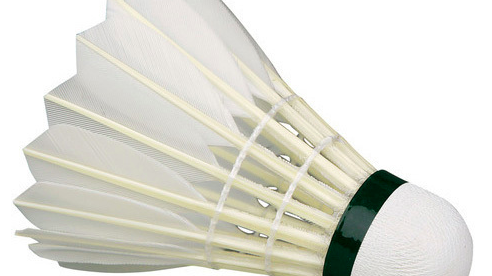Badminton’s Sinister Secret


Badminton is a sport that, for many, is an informal summertime outdoor activity. You string a net across a portion of a backyard or the beach, grab some lightweight rackets, and hit something called a shuttlecock or birdie over the net. It’s like tennis is some ways, but the shuttlecock (seen above) doesn’t fly as a tennis ball would — it floats, kind of, spinning through the air. If you’re good at badminton, you can spike the shuttlecock, making it dive rather quickly. And that’s a good strategy: if the shuttlecock lands on your opponent’s side of the net, your team wins the point.
One of the biggest problems with backyard badminton, though, are the shuttlecocks themselves. They’re typically made of cheap plastic and they get damaged very easily; the little fins on the back get bent or dented, causing the birdie to drift unpredictably. If you’re looking to spend some quality time with the family while the hamburgers cook on the grill, that’s no big deal — you play for a bit and then eat. But if you’re a competitive badminton player it’s very, very important that the shuttlecock flies true.
Which is why there are some geese out there with naked left wings. Kind of.
There are a lot of very serious badminton players out there; it’s been an Olympic sport since 1992, and there have been international confederations regulating the sport since the 1950s. Competitive badminton matches don’t the cheap plastic shuttlecocks. They use ones that have real feathers, from a goose or a duck, like the one seen above, and can run about $3 each. And not any feathers will do — most competitive badminton tournaments prefer geese feathers, and in most cases, only use the feathers from the left wing of the geese in question.
Why? Aerodynamics. In 2013, a deputy commissioner of the Badminton World Federation named Paisan Rangsikitpho explained to Seattle magazine The Stranger that “the goose’s left wing and right wing are curved differently. If you look with your eye, you may not see it, but it’s the way the feathers shape and flow.” Continues The Stranger, “A shuttlecock made from the feathers of the left wing will spin clockwise. One made from the feathers of the right wing will spin differently—an inconsistency that screws up the game.” Mixing left-wing and right-wing feathers isn’t an option — it will cause the shuttlecock to wobble.
Manufacturers don’t have to use only left-wing feathers; Yondex, leading a shuttlecock manufacturer, explains (pdf) that they’ll use either: “The feathers used for producing one shuttlecock are 16 feathers from either right or left-wing. (They note, though that they “don’t use feathers from both right and left wings for one shuttlecock as this affects flight.” But in 2016, Satoshi Yuza, a promotions manager at Yondex told the New York Times that “only feathers from the left wings of geese are used in the tournament shuttles.” (The feathers from the right wing are used for lower-quality birdies.) There’s no good reason for why the left wing feathers won out, but the practice has become the expected convention in competitive badminton.
And no, that doesn’t mean there are a lot of featherless geese out there. Per Rangsikitpho, in the early part of this century, “animal-rights activists tried to make a stink about the use of goose feathers, but he explained to them that it was a by-product—the geese are bound for butcher shops or being plucked for down pillows and jackets. If the feathers of their left wings weren’t used for shuttlecocks, they’d be used for something else, or just thrown away.”
Bonus fact: The title above calls the left-wing feathers a “sinister” secret — but there’s nothing mean or evil about badminton. So, why use that word? “Sinister” has an odd but relevant etymology — it comes from the Latin word sinister, which meant “left” or “on the left side.” Per Etymology Online, “the Latin word was used in augury in the sense of ‘unlucky, unfavorable’ (omens, especially bird flights, seen on the left hand were regarded as portending misfortune), and thus sinister acquired a sense of ‘harmful, unfavorable, adverse.'” Apparently, pro badminton players aren’t very superstitious.
From the Archives: Bad-Minton: Badminton may be responsible for the greatest in-competition scandal in Olympic history.
